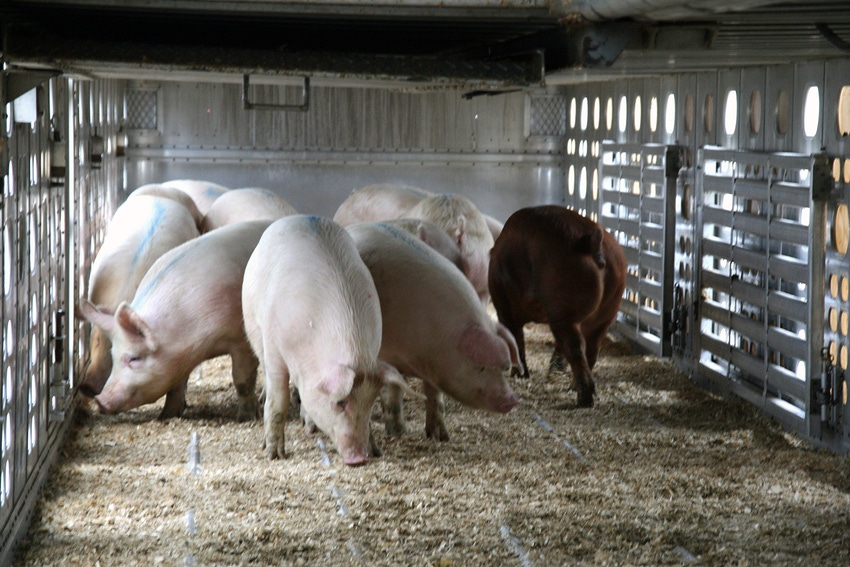Light versus heavy barrow fecal microbiome at finishing
Understanding differences between market hogs may provide insight into growth performance, feed efficiency and swine industry sustainability.
January 18, 2024

By Ryan Samuel, Benoit St-Pierre and Emily Fowler, South Dakota State University
Natural variation in the body weights of growing pigs affects how pigs are managed and marketed. There are many known factors that influence the growth performance of pigs. However, more recently, the importance of the microbial communities residing in the gastrointestinal tract and their contributions to digestion, nutrient absorption and immune function have been investigated.
Light and heavy market hogs may exhibit distinct microbial profiles influenced by their feeding behaviors and influencing their growth rates. Specifically, understanding the differences in the microbiome between light and heavy market hogs may provide insights into optimizing growth performance, feed efficiency and sustainability of the swine industry. Therefore, the fecal microbiomes at finishing of light versus heavy barrows were investigated.
Light versus heavy
A total of 1,097 pigs at the South Dakota State University commercial wean-to-finish research facility were housed in 45 pens of one of three different sex-based groups: 1) gilts only, 2) mixed gilts and barrows, and 3) barrows only.
There were six barrow-only pens selected for collection of fecal samples for microbial composition because of their greater body weights compared to all other pens in the barn. All barrows had the same number of days on feed and samples were collected the day before pigs were shipped to the processing plant.
Barrows were individually weighed and hogs weighing less than 275 lbs and hogs weighing more than 305 lbs were assigned to the ‘light’ and ‘heavy’ group, respectively. Fresh fecal samples were collected from 21 ‘light’ and 23 ‘heavy’ barrows, stored frozen, and then processed for bacterial composition of the 16S rRNA bacterial gene.
Results
The results of operational taxonomic unit composition analysis determined that there was a high degree of overlap between the fecal microbiome of ‘light’ and ‘heavy’ hogs (i.e. 5050 of 9066 shared). However, there were 1736 and 2280 OTUs unique to the ‘light’ and ‘heavy’ groups, respectively.
Further analysis seeking individual bacterial species identification revealed that six OTUs were higher in the ‘light’ group and eleven OTUs were higher in the ‘heavy’ group. Within the 17 total differentially expressed OTUs, there were only two nucleotide sequences that may represent strains of known species and the remaining nucleotide sequences likely correspond to 15 unknown bacterial species. The known species, Clostridium jeddahitimonense and Clostridium beijerinckii were both found in higher abundance in the samples from the ‘light’ group; the former is known to metabolize D-tagatose, but not other common monosaccharides, while the latter can hydrolyze starch and ferment glucose. While their metabolic capabilities indicate that they may be responsive to compounds in the diet, further research will be required to determine why these two species were found to be more abundant in light barrows.
A balanced microbiome is essential for efficient nutrient utilization and promoting weight gain in growing and finishing swine. The development of beneficial microbial populations can contribute to feed conversion efficiency and the overall health of the animals.
Producers may implement strategies, such as probiotics or prebiotics, to modulate the swine microbiome and optimize growth outcomes in both light and heavy market hogs. However, it appears that further investigation of the swine microbiome may focus on determining the metabolic properties of uncharacterized species as well as the feedstuffs and conditions that promote those species which provide positive benefits to growing and finishing swine.
In conclusion, the microbiome of market hogs is a pivotal aspect of their physiology, impacting growth, health and overall performance. Exploring the nuances between the microbiomes of light and heavy market hogs can open avenues for targeted interventions, ultimately benefiting both individual producers and the swine industry.
Reference:
You May Also Like



